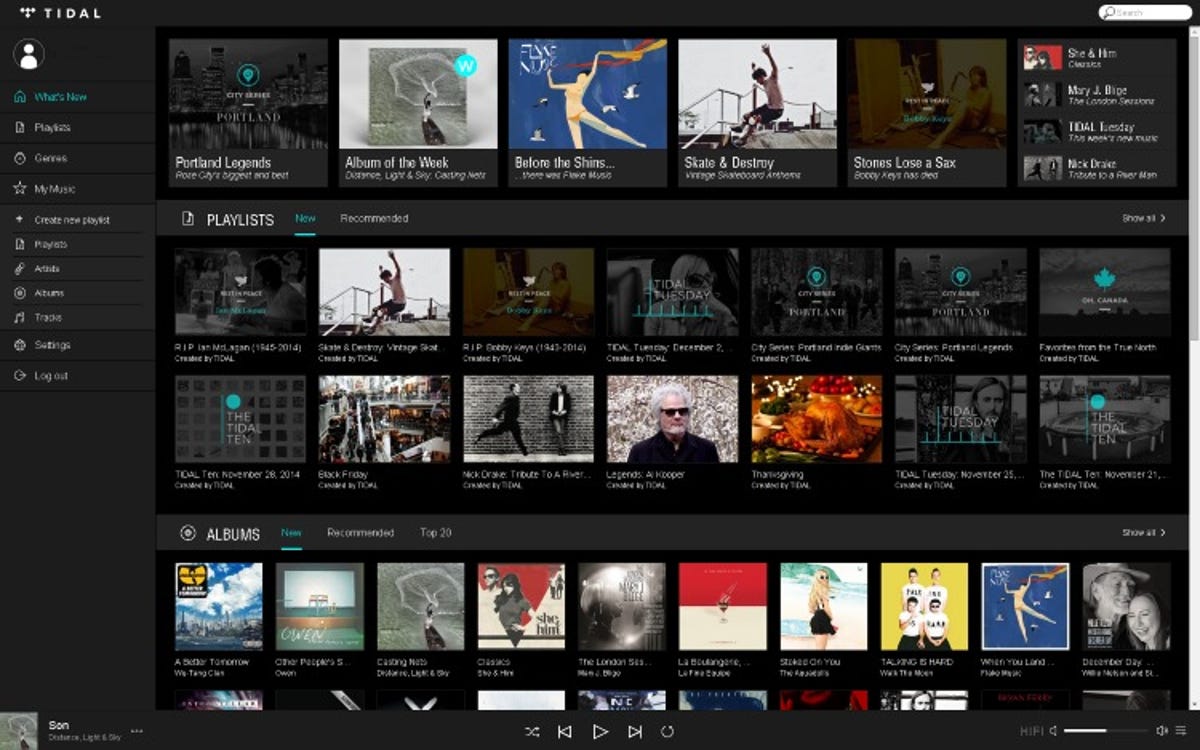
Screenshot: Ty Pendlebury/CNET
Sonos has become the latest manufacturer to announce support for the fledgling streaming music service Tidal, which launched in the UK and the US in late 2014. But what makes Tidal different from the gaggle of other services on the market? In a word: lossless.
If that term is Greek to you, you’re not alone. But the promise of lossless audio — and Tidal’s marketing pitch — goes back to the Faustian bargain of iPod era, in which we all traded out quality for quantity. Nearly all of the mainstream downloadable (iTunes, Amazon) and streaming (Spotify, Beats, Pandora) services utilize so-called “lossy” compression formats like MP3 or AAC, which discard some of the audio in order to keep file sizes down. By contrast, lossless audio formats — as the term suggests — keep the original audio intact, delivering music that’s akin to true CD quality.
And that’s where services like Tidal come in. The Nordic streaming service (perhaps better known by its WiMP moniker in some markets) has joined Deezer+ and Murfie by offering premium lossless streams for paying subscribers only. At present, Tidal’s service is set at $19.99 or £19.99 per month and Tidal CEO Andy Chen said there is no advertising-paid, or “free” option.
“Why would you rob yourself of such a luxury? Quality is worth paying for,” Chen said in a conversation with CNET.
Premium quality, premium price
Tidal entered the market in late October 2014 with a catalog of 25 million tracks and ripped at the maximum 1411kbps bitrate in Apple Lossless and FLAC formats. Tidal users can also download music for offline listening. By comparison, Spotify uses the Ogg Vorbis format, a form of lossy compression encoded at a maximum 320kbps. In terms of its position in the music market, Tidal sits in the middle between Spotify and sites which offer lossless downloads.
“We launched in the US and the UK and we’re looking to expand to 50 markets, but at the moment we can’t say which markets and how soon,” Chen said.
Related Links
- Top 6 sites for buying lossless music
- Deezer enters US market with Elite lossless service
- Poll: What’s your favorite music format?
However, Chen did add that he was very interested in the US and Canada particularly due to the comparatively healthy sales of hi-fi in those countries.
In addition to Sonos, the app is currently available on up to 35 platforms including Android, iOS, and Internet browsers, with up to 10 more coming by the start of 2015 according to Chen. One of the platforms currently in beta, Logitech Squeezebox , may surprise some as Logitech withdrew the products from sale over 2 years ago. Chen said that despite the number of different platforms available the most popular consumption method is the Tidal website.
According to Chen, the company further distinguishes itself from its lossless competition by also offering high-definition music videos and would look at adding high-res (24-bit) streaming without charging extra.
Paying the piper
In November, Taylor Swift withdrew her back catalog from Spotify in protest at what she claimed were the poor rates paid to artists. Chen says that the dispute hasn’t extended to Tidal — the service has all of her albums bar “1989,” her latest — and he claims it’s because Tidal pays twice the going industry rate due to its pricing system. Chen declined to detail what its rate was and there is even debate about how much Spotify pays its artists. Spotify CEO Daniel Ek says the company has paid out more than $1 billion to rights holders in 2014, while there are multiple reports of popular artists earning as little as half a penny per track. (Those numbers, of course, are not necessarily mutually exclusive.)
When asked if Tidal was doing anything to improve payouts further, Chen said “we are not the only people setting the price,” adding it was an industry-wide negotiation.
Regardless of current payment disputes, it’s undeniable that the public is demanding the convenience of music streaming services. But will they pay for higher quality? Chen says that the consumer mindset needs to change if the industry is going to survive. Especially when only 8 million of Spotify’s 36 million users currently pay a subscription fee.
“Music should not be free and people should pay,” he said.
But can listeners hear the difference? CNET has conducted listening tests in the New York audio labs comparing Tidal lossless against Spotify and hi-res, 24-bit downloads. Look out for the results in the Audiophiliac blog in the near future.




